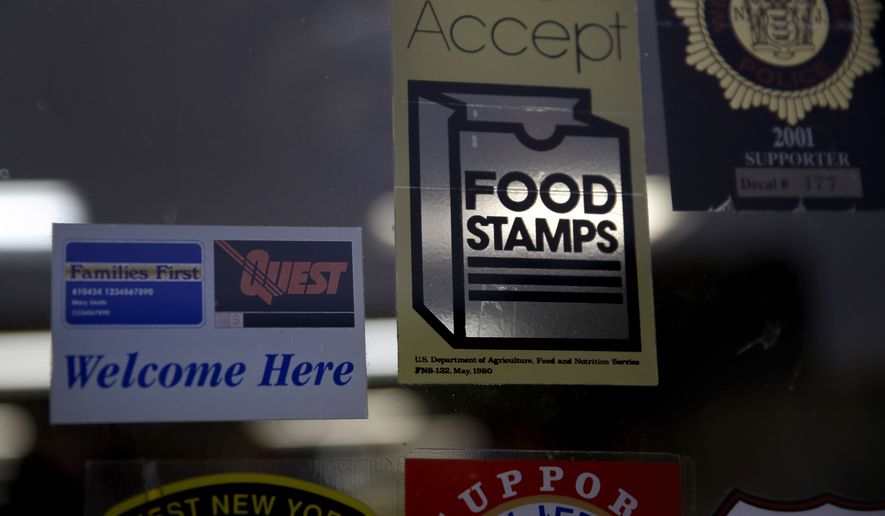Officials in Maryland several years ago managed to disable one of the systems intended to check whether food stamp applicants had low enough income to qualify for the benefit.
The result, according to a state audit, was tens of thousands of people collecting benefits they didn’t deserve.
Even after the state flagged the problem, it continued to pay the benefits. Some 75% in test cases were still getting benefits months later, the audit found.
Sen. Joni Ernst, the Senate’s top waste-watcher, said that type of error has the Agriculture Department’s food stamp program, officially named the Supplemental Nutrition Assistance Program, blowing nearly $1 billion a month in overpayments on double-dippers or wholly ineligible recipients.
“Folks, you don’t get to make errors like this when you are calculating your taxes, so they shouldn’t be tolerated by those spending your taxes!” the Iowa Republican said as she slapped the food stamp program with her monthly “Squeal Award” for buffoonish spending.
Food stamps are federally funded and state-administered. The program has a nearly 10% overpayment rate nationwide. That glosses over some truly troubling states such as Alaska, which notched a 57% overpayment rate last year, and Maryland, where roughly one-third of all payments were too high.
Those rates underreport the problem.
Under federal law, errors of $54 or less don’t have to be included in the states’ improper payment calculations.
Ms. Ernst is announcing legislation Tuesday to eliminate the error “tolerance threshold” and require a more exact accounting of waste.
Her bill would also prod states to do a better job of weeding out ineligible families or else be forced to cover some of those costs themselves.
She said it was particularly galling that Maryland, despite paying food stamp benefits to 86,479 households that didn’t qualify, has no plans to retrieve the money. The state said the pandemic amounted to a free pass.
Even more appalling to Ms. Ernst were the cases in which food stamp fraud was led by the very people who run the food stamp program in the states.
She pointed to one case in Mississippi where the man who led the state’s criminal investigations into food stamp fraud turned out to have cheated the system himself. He pleaded guilty in 2019 to a scheme in which he extorted money from stores by threatening to pursue fraud charges against them unless they paid “restitution” — only he kept the money for himself.
In an earlier case out of Delaware, seven employees at the state agency that oversees food stamps were charged with stealing nearly $1 million in benefits. They devised a scheme to create fake beneficiaries and then collected the benefits themselves.
Ms. Ernst is scrutinizing food stamps as the government as a whole reels from incalculable levels of fraud, particularly in the wake of the pandemic emergency.
The Government Accountability Office recently reported that as much as $135 billion in pandemic unemployment benefits went to fraudsters, or about 15% of all the money spent. Much of that went to criminal syndicates operating abroad, including some tied to adversary nations such as Russia and China.
For food stamps, criminal groups may be taking as much as $3 billion a month out of the program, according to an estimate by Haywood Talcove, CEO of government at LexisNexis Risk Solutions.
He said the gangs use stolen identities and artificial intelligence to fool state systems.
That includes ongoing problems with unemployment benefits, food stamps, and other welfare programs such as Temporary Assistance for Needy Families, which cuts monthly checks.
“What happened during COVID is the criminals learned that government is the easiest place to steal from. And they’re accelerating,” Mr. Talcove told The Washington Times this summer. “Until the government hardens its systems, then they’re going to continue. Trying to catch them, with this many doing it, is virtually impossible. There’s just not enough resources.”
Ms. Ernst, who won her Senate seat in 2014 by touting her experience growing up castrating pigs on an Iowa farm and who vowed to make the big spenders in Washington “squeal,” said food stamps play a vital role in keeping food on the table of those truly in need.
She said the program has spun out of control, with tens of thousands of families stuck in a backlog waiting to be approved by agencies that have employed fraudsters.
“Instead of giving billions in benefits to those who don’t qualify or doubling payments for others already being served, let’s set a place at the table for the families who do qualify but are going without while they wait in line,” Ms. Ernst said.
Food stamps’ overpayment rate has grown from about 6% in 2019, before the pandemic, to roughly 10%.
The Center on Budget and Policy Priorities said in a policy brief this summer that the program has “extensive” accuracy checks and performs better than other areas of the federal government, such as tax collection. The IRS says about 15% of owed taxes aren’t being paid.
The SNAP program is due to be reauthorized in an upcoming farm bill.
• Stephen Dinan can be reached at sdinan@washingtontimes.com.




Please read our comment policy before commenting.